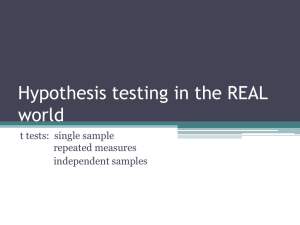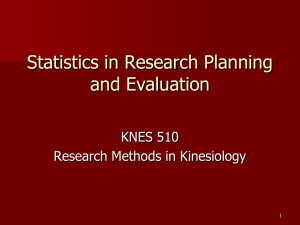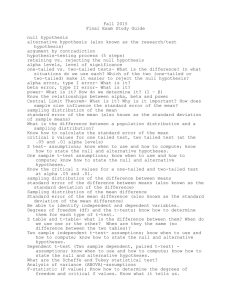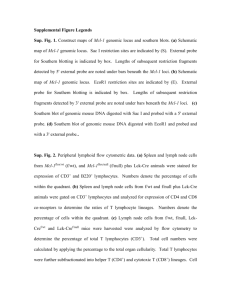Wallis` technique of finding arbitrary limit of a sequence
advertisement
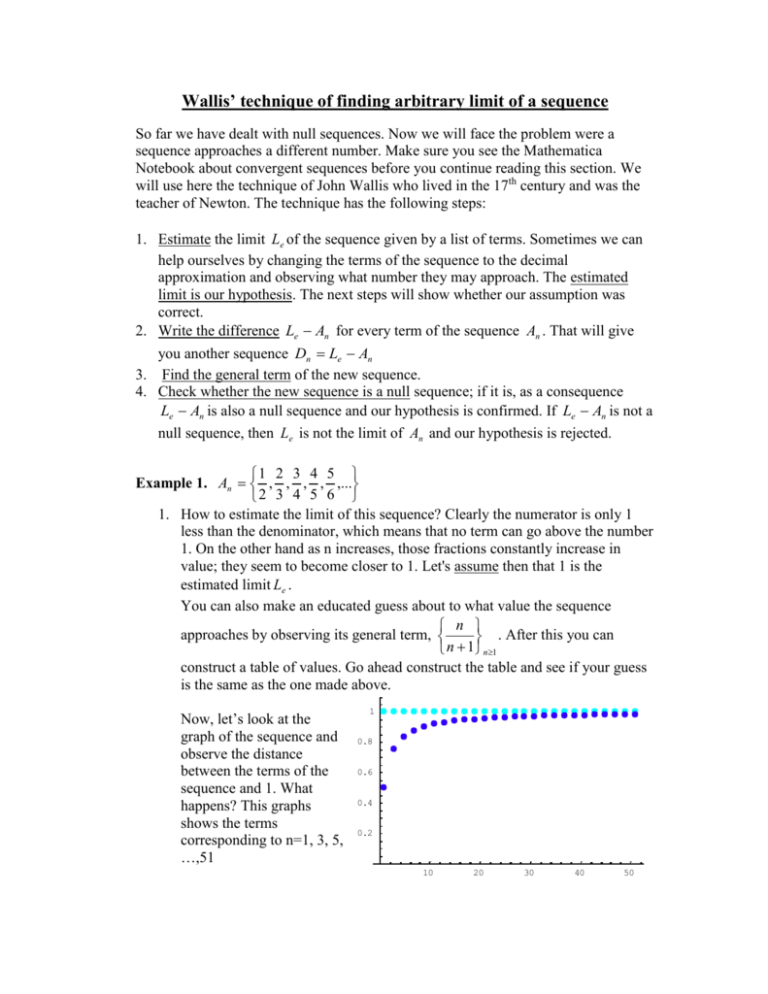
Wallis’ technique of finding arbitrary limit of a sequence So far we have dealt with null sequences. Now we will face the problem were a sequence approaches a different number. Make sure you see the Mathematica Notebook about convergent sequences before you continue reading this section. We will use here the technique of John Wallis who lived in the 17th century and was the teacher of Newton. The technique has the following steps: 1. Estimate the limit Le of the sequence given by a list of terms. Sometimes we can help ourselves by changing the terms of the sequence to the decimal approximation and observing what number they may approach. The estimated limit is our hypothesis. The next steps will show whether our assumption was correct. 2. Write the difference Le An for every term of the sequence An . That will give you another sequence Dn Le An 3. Find the general term of the new sequence. 4. Check whether the new sequence is a null sequence; if it is, as a consequence Le An is also a null sequence and our hypothesis is confirmed. If Le An is not a null sequence, then Le is not the limit of An and our hypothesis is rejected. 1 2 3 4 5 Example 1. An , , , , ,... 2 3 4 5 6 1. How to estimate the limit of this sequence? Clearly the numerator is only 1 less than the denominator, which means that no term can go above the number 1. On the other hand as n increases, those fractions constantly increase in value; they seem to become closer to 1. Let's assume then that 1 is the estimated limit Le . You can also make an educated guess about to what value the sequence n approaches by observing its general term, . After this you can n 1 n1 construct a table of values. Go ahead construct the table and see if your guess is the same as the one made above. Now, let’s look at the graph of the sequence and observe the distance between the terms of the sequence and 1. What happens? This graphs shows the terms corresponding to n=1, 3, 5, …,51 1 0.8 0.6 0.4 0.2 10 20 30 40 50 2. Now that we have a good feeling for what happens between the terms of the sequence and Le 1 , we find the sequence D n . There are two ways to do so: a. Find a general term for An and then see that 1 An is a null sequence. In n n 1 , n 1 whence 1 An 1 this case An which is n 1 n 1 n 1 null. b. The second way is to look at the differences and show they are a null sequence. 1 1 2 1 3 1 n 1 D1 1 D2 1 D3 1 … D n 1 2 2 3 3 4 4 n 1 n 1 1 is a null sequence, the larger n gets, the closer the difference between 1 and n 1 An gets to zero. Since This discussion amounts to saying that in order to show that An 1, it has to be shown that 1 An 0 or what is the same An 1 0 Example 2 1 2 3 4 C n , , , ,.... 3 5 7 9 1. Can you guess what value the sequence is approaching to? 2. What is a pattern to describe this sequence? 3. From constructing tables of values guess the value the sequence is getting closer to. 1 4. I hope by now you guess is 2 1 5. Now with this guess, let’s show that Bn C n is a null sequence. We will try 2 both ways again: a. Find a pattern for C n . The numerators are 1, 2, 3, 4 … which corresponds to the sequence nn 1 . The denominators are 3, 5, 7, 9, … which corresponds to the sequence 3 2nn0 3 2(n 1)1 2n 1n1 . So, n Cn , n 1 . From here we have that 2n 1 1 n 1 1 2 2n 1 2(2n 1) 4n 2 b. We will perform subtractions for some of the first terms of the sequence. 1 1 1 1 2 1 1 3 1 B1 B2 B3 2 3 6 2 5 10 2 7 14 To find the general term, notice that the sequence has fractions with numerator 1 and denominators 6, 10, 14 so far. If the pattern continues the next denominator should be 18. Let’s double check 1 4 1 B4 . It works. The denominators have the pattern 6 4n, n 0 . But since we 2 9 18 want to start from n=1, then the pattern is 6 4(n 1) 2 4n, n 1 . Thus, 1 Bn . 2 4n 6. Finally, one needs to find the general term and write it in the rectangle. 1 The sequence you found is that is a null sequence. 4n 2 1 1 1 1 7. We have shown also that Bn is a null, because Bn = , and 2 2 4n 2 4 n 2 1 therefore, according to the definition, is indeed the limit of our sequence. 2 ALGEBRAIC SHORTCUTS What we have done so far is to show using Wallis’ technique how to find the limit of a convergent sequence. However, many times we can use algebra to find the limit of the sequence. n Consider the sequence An from example 1. Since we want to find n 1 n n n 1 Lim Lim ( ) Lim 1 n n 1 n n 1 n n 1 1 n n ,n 1. 2n 1 n n n 1 1 Lim Lim * Lim n 2 n 1 n 2 n 1 n n 1 2 2 n For the case of example 2, we have that C n EXERCISE: Justify the following claims: The sequence an 3.8, n 1 has a limit. n n The sequence a n 2 1 has a limit. 2n 1 n 1 The sequence bn 2 1 0.001, n 1 does not converge to any number. The sequence cn n, n 1 does not converge. 1 The sequence d n 2 n , n 1 converges. 2 Definition Precise: The sequence a n has L as its limit, if for any 0 , one can find N so that an L for any n >N. It is, the distance between a term and the limit is less than 0 , for any term satisfying n >N. Conceptual: The sequence an has L as its limit if we can make the terms of the sequence to be as close to L as we wish for N sufficiently large. A sequence a n that has a limit L is said to converge to L and it is denoted as Lim a n L . n EXERCISE Use the Wallis method to determine the limit of the following sequences whenever it exists. 1. C n 3, 2, 2. Cn n 3 3. Cn 9 12 15 18 , , , ,......} 5 7 9 11 3n 1 n From all our discussion of a convergent sequence we can claim that whenever a sequence a n converges to a number L, an L NullSequence , where the null sequence can be either positive or negative. EXERCISE For each of the following sequences, determine algebraically whether or not they converge. Whenever they converge, express the sequence as a constant-Null sequence. 3n 2 2 4n 2 n 1 n 2. bn 2 n2 2 n n 100 3. cn (n 20)( n 50) 4. Give three examples of null sequences (include at least one alternating sequence). Use them to generate three sequences which converge to -3.5. 1. an


